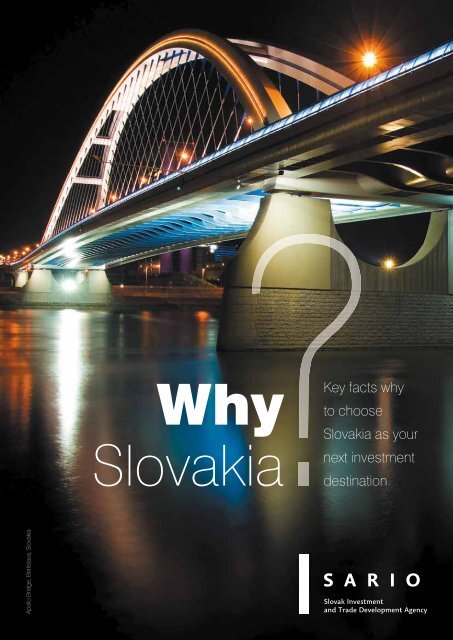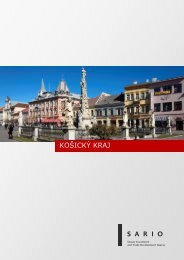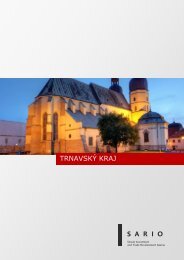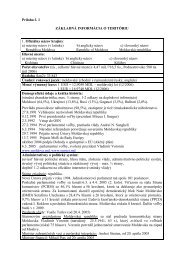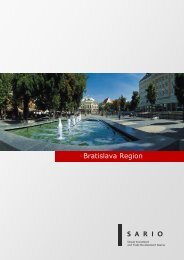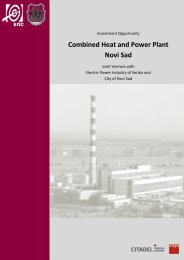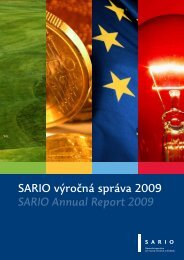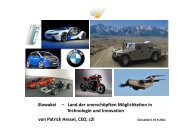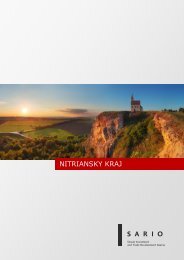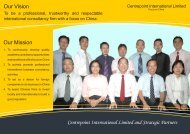Key facts why to choose Slovakia as your next investment ... - Sario
Key facts why to choose Slovakia as your next investment ... - Sario
Key facts why to choose Slovakia as your next investment ... - Sario
Create successful ePaper yourself
Turn your PDF publications into a flip-book with our unique Google optimized e-Paper software.
Why<br />
<strong>Slovakia</strong><br />
<strong>Key</strong> <strong>facts</strong> <strong>why</strong><br />
<strong>to</strong> <strong>choose</strong><br />
<strong>Slovakia</strong> <strong>as</strong> <strong>your</strong><br />
<strong>next</strong> <strong>investment</strong><br />
destination.<br />
Apollo Bridge, Bratislava, <strong>Slovakia</strong>
Introduction<br />
“Why <strong>Slovakia</strong>” is a brochure that is designed <strong>to</strong> acquaint<br />
the reader with the economic <strong>facts</strong> and figures, supply<br />
information on the business environment, sec<strong>to</strong>r strengths,<br />
vision, and strategy for economic development and other<br />
useful data in order <strong>to</strong> illustrate Why <strong>Slovakia</strong> is an ideal<br />
location for business. We hope that this brochure will<br />
encourage you <strong>to</strong> consider <strong>Slovakia</strong> <strong>as</strong> an ideal destination<br />
for <strong>your</strong> <strong>investment</strong>.<br />
5 <strong>Key</strong> re<strong>as</strong>on <strong>to</strong> invest in <strong>Slovakia</strong><br />
1. Currency - EURO<br />
2. Productivity <strong>to</strong> Labour Costs - the highest in CEE<br />
3. Flat Tax System - 19% & no taxes on dividends<br />
4. E<strong>as</strong>e of doing business - the highest in CEE<br />
5. Attractive and competitive country ratings<br />
<strong>Slovakia</strong><br />
Sweden<br />
Finland<br />
1500 km<br />
Norway<br />
1250 km<br />
1000 km<br />
Es<strong>to</strong>nia<br />
Russia<br />
Denmark<br />
750 km<br />
Latvia<br />
Lithuania<br />
Russia<br />
Ireland<br />
500 km<br />
Belarus<br />
United Kingdom<br />
Netherlands<br />
Belgium<br />
Germany<br />
Poland<br />
250 km<br />
Louxembourg<br />
Czech Republic<br />
Ukraine<br />
<strong>Slovakia</strong><br />
Moldova<br />
Liechtenstein<br />
Austria<br />
France<br />
Switzerland<br />
Italy<br />
Slovenia<br />
Croatia<br />
Hungary<br />
Romania<br />
Monaco<br />
San<br />
Marino<br />
Bosnia and<br />
Herzegovina<br />
Serbia<br />
Montenegro<br />
Kosovo<br />
Bulgaria<br />
Albania<br />
Macedonia<br />
Portugal<br />
Spain<br />
Greece<br />
Turkey
“<strong>Slovakia</strong> ranks in the <strong>to</strong>p 10 when it comes <strong>to</strong> the e<strong>as</strong>e of<br />
registering property and the <strong>to</strong>p 5 in terms of lowest costs <strong>as</strong><br />
a percentage of property value.”<br />
Source: Doing Business Report 2011, World Bank and IFC<br />
“<strong>Slovakia</strong> ranks 10 th out of 139 countries in terms of pay and<br />
productivity.”<br />
Source: Global Competitiveness Report 2010-2011, World Economic Forum<br />
”<strong>Slovakia</strong>, the one-time laggard turned reforming star.”<br />
The Economist, 29 March 2008<br />
The largest cities and <strong>to</strong>wns<br />
City/Town<br />
Population<br />
Bratislava Area 601,132<br />
Košice 235,006<br />
Prešov 91,767<br />
Nitra 85,742<br />
Žilina 85,268<br />
Banská Bystrica 81,704<br />
Trnava 69,140<br />
Trenčín 56,850<br />
Source: The Statistical office of the Slovak Republic, 2010<br />
Establishment: 1 st January 1993<br />
Total Area: 49,035 km 2<br />
Population:<br />
Capital:<br />
Membership:<br />
5,4 million<br />
Bratislava<br />
OECD, EU, WTO, NATO, UN, Schengen area<br />
Language: Slovak (official), English 85%, German<br />
61%, French 8%, Russian 8%, Spanish 3%,<br />
Hungarian & other Slavic languages<br />
Currency: EURO<br />
Government: Parliamentary Democracy<br />
Prezident: Ivan Gašparovič<br />
Prime Minister: Iveta Radičová<br />
Election term: 4 years<br />
Neighbours: Hungary, Czech Republic, Poland, Austria,<br />
Ukraine<br />
Time zone: GMT +1 hour<br />
The Slovak economy h<strong>as</strong> been following a path of robust<br />
growth driven mainly by rising FDI inflows. In the year 2007<br />
<strong>Slovakia</strong> experienced the highest GDP growth among all EU<br />
countries at a m<strong>as</strong>sive 10.6%. In 2010 the GDP started <strong>to</strong><br />
rise again and w<strong>as</strong> the highest in the EURO zone, and at the<br />
same time <strong>Slovakia</strong>´s GDP growth w<strong>as</strong> the second highest<br />
among all EU members.<br />
Macroeconomic figures<br />
2007 2008 2009 2010 2011<br />
Real GDP Growth 10.4% 6.4% -4.7% 4% 3.5% (1Q 2011)<br />
Inflation (HICP) 1.9% 3.9% 0.9% 0.7% 3.6% (1H 2011)<br />
Registered level of unemployment 8.4% 7.7% 11.4% 12.48% 12.92% (2Q 2011)<br />
SKK/EUR** 33,78 31,29 30,1260 (official since 1. 1. 2009)<br />
Export in EUR billion 47,3 49,5 39,7 48,791 22,65 (1. - 5. 2011 )<br />
Nominal wage inflation (conversion rate) 7.4% 8.1% 3.0% 3.2% 2.9% (1Q 2011)<br />
Source: The Statistical office of the SR, National Bank of <strong>Slovakia</strong>, The Central Office of Labour, Social Affairs and Family of the SR, 2011<br />
Slovak export in 2010 h<strong>as</strong> again incre<strong>as</strong>ed due <strong>to</strong> the rising demand on the foreign markets and expanding production in the<br />
key industrial sec<strong>to</strong>rs in <strong>Slovakia</strong>. In general, 90% of the Slovak export goes <strong>to</strong> OECD countries.<br />
Member of the Eurozone<br />
<strong>Slovakia</strong> , <strong>as</strong> the 16 th state<br />
in a row, h<strong>as</strong> adopted the<br />
EURO currency, being<br />
the first among the CEE<br />
countries.<br />
EURO<br />
IMPLEMENTATION<br />
IMPACT<br />
1 st January 2009<br />
<strong>Slovakia</strong> joined<br />
the EURO Zone<br />
• Limitation of Foreign<br />
Exchange Risk<br />
• Lowering Transaction<br />
Costs<br />
• Growth in Foreign<br />
Trade<br />
• Incre<strong>as</strong>ed Financial<br />
Stability
Labour productivity vs. Labour costs<br />
Labour productivity is expressed <strong>as</strong> GDP per hour worked. It<br />
is intended <strong>to</strong> give a picture of the productivity of national<br />
economies shown in relation <strong>to</strong> the European Union (EU-15)<br />
average. B<strong>as</strong>ic figures are manifested in Purch<strong>as</strong>ing Power<br />
Standards (PPS), i.e. a common currency that eliminates<br />
the differences in price levels between countries allowing<br />
meaningful volume comparisons of GDP between countries.<br />
Gross monthly salary<br />
Czech Rep.<br />
976 EUR<br />
23 951 CZK<br />
Poland<br />
806 EUR<br />
3 224,98 PLN<br />
<strong>Slovakia</strong><br />
769 EUR<br />
Hungary<br />
760 EUR<br />
202 576 HUF<br />
Romania<br />
472 EUR<br />
1936 RON<br />
Bulgaria<br />
328 EUR<br />
642 BGN<br />
Data for 2010 Source: National Statistical offices of Czech republic, Hungary, Poland, <strong>Slovakia</strong>, Bulgaria, Romania exchange rate (<strong>as</strong> of 23 March 2011)<br />
90<br />
80<br />
70<br />
60<br />
50<br />
40<br />
30<br />
20<br />
10<br />
0<br />
2003 2004 2005 2006 2007 2008 2009 2010<br />
<strong>Slovakia</strong><br />
Hungary<br />
Romania<br />
Czech Republic<br />
Poland<br />
Bulgaria<br />
Source: Eurostat, www.epp.<br />
eurostat.ec.europa.eu, 2010,<br />
EU 15 = 100<br />
Education<br />
<strong>Slovakia</strong> reaches one of the highest shares of workforce with the<br />
secondary, higher and the university education among all the<br />
European countries.<br />
Furthermore, the share of people with a university education is<br />
on the rise.<br />
15.68%<br />
37.17%<br />
0.01% 6.75%<br />
40.39%<br />
No education<br />
Elementary school<br />
Secondary General School<br />
Secondary Vocational School<br />
University education<br />
Source: Statistical Office of the Slovak<br />
Republic, www.statistics.sk, 2010<br />
University education<br />
There are 33 universities in <strong>Slovakia</strong> spread all over the country.<br />
In the academic year 2009/2010, there were 211,553 students<br />
enrolled at Slovak universities and 69,809 graduated (both<br />
data include Bachelor and M<strong>as</strong>ter studies). <strong>Slovakia</strong> is among<br />
the <strong>to</strong>p countries in the world of secondary schol graduates<br />
attending university.<br />
Secondary schools<br />
<strong>Slovakia</strong> h<strong>as</strong> a well established system of specialized training and<br />
vocational schools. To accommodate the changing requirements<br />
on the labour market, secondary schools are being given a higher<br />
degree of control in creating their own educational programs <strong>to</strong><br />
meet the current needs of the local industry.<br />
The most common foreign languages taught at Slovak secondary schools in 2009/2010 were:<br />
English<br />
85.76%<br />
French<br />
7.93%<br />
Spanish<br />
2.99%<br />
German<br />
60.84%<br />
Russian<br />
7.56%<br />
Italian<br />
0.72%<br />
The subject of studies is following:<br />
technical sciences<br />
IT<br />
natural sciences<br />
economy<br />
social sciences<br />
health<br />
Students<br />
Graduates<br />
Source: The Institute<br />
for Information and<br />
Prognosis in Education,<br />
www.uips.sk, 2010,<br />
SARIO calculations, 2010<br />
0<br />
10 000 20 000 30 000 40 000 50 000 60 000 70 000 80 000 90 000
Simple and Fair Taxes<br />
The progressive business-friendly tax regime h<strong>as</strong> been in<br />
effect since January 2004. This highly competitive regime and<br />
a great advantage of the Slovak business environment h<strong>as</strong><br />
inspired several neighbouring countries <strong>to</strong> adopt a similar<br />
taxation model. All incomes are taxed at the flat rate of 19%<br />
without any progression.<br />
The VAT rate of 20% is a temporary provision reflecting<br />
current budgetary deficit and is expected <strong>to</strong> be decre<strong>as</strong>ed<br />
back <strong>to</strong> 19% in 2013.<br />
19% Flat TAX rate<br />
Corporate Income Tax<br />
Personal Income Tax<br />
19%<br />
Dividend tax<br />
Inheritance and Gift Tax<br />
Real Estate Transfer Tax<br />
0%<br />
Repatriation of profits 100%<br />
E<strong>as</strong>e of doing business<br />
B<strong>as</strong>ed on the World Bank e<strong>as</strong>e of doing business ranking<br />
considers the quality or attractiveness of the business<br />
environment. The rating fac<strong>to</strong>rs are: political and<br />
institutional environment, macroeconomic stability, market<br />
potential, private entrepreneurship support, taxation<br />
system, finance, enforcing contracts, starting and closing of<br />
a business, labour market and infr<strong>as</strong>tructure.<br />
70<br />
51<br />
56<br />
63<br />
41<br />
42<br />
46<br />
1<br />
Source: Doing Business Report 2010, World Bank, www.doingbusiness.org, 2011
Country credit rankings<br />
<strong>Slovakia</strong> is generally recognized <strong>as</strong> an open market economy,<br />
which is able and willing <strong>to</strong> pay its liabilities.<br />
The following table shows the various credit ratings for<br />
the CEE countries. <strong>Slovakia</strong> h<strong>as</strong> maintained its positive<br />
momentum and competitive values. This is a great advantage<br />
for foreign inves<strong>to</strong>rs, <strong>as</strong> it means that <strong>Slovakia</strong>, Slovak banks<br />
and companies are in a strong financial position and are<br />
able, and willing, <strong>to</strong> repay their debts. In spite of the current<br />
situation, <strong>Slovakia</strong> is one of the few countries <strong>to</strong> maintain a<br />
stable/positive outlook, in which our ratings are not expected<br />
<strong>to</strong> change in the near future.<br />
Country Standard and Poor’s Moody’s Fitch<br />
OECD Country Risk<br />
(the lower the better)<br />
<strong>Slovakia</strong> A+ positive outlook A1 stable outlook A+ stable outlook 0<br />
Czech Republic AA- stable outlook A1 stable outlook A+ positive outlook 0<br />
Poland A- stable outlook A2 stable outlook A- stable outlook 2<br />
Hungary BBB- negative outlook Baa3 negative outlook BBB- stable outlook 0<br />
Source: Standard & Poor’s, www.standardandpoors.com; Moody’s, www.moodys.com; Fitch, www.fitchratings.com; OECD Country Risk Report, www.oecd.org, 2011<br />
<strong>Key</strong> sec<strong>to</strong>rs<br />
<strong>Slovakia</strong> prides itself on its industrial heritage which h<strong>as</strong><br />
provided a stable b<strong>as</strong>e for the development of certain sec<strong>to</strong>rs<br />
such <strong>as</strong> au<strong>to</strong>motive or electronics. During the p<strong>as</strong>t couple of<br />
years, global corporations representing various industries<br />
have selected <strong>Slovakia</strong> <strong>as</strong> the <strong>to</strong>p location for their expansion<br />
in the CEE region.<br />
Au<strong>to</strong>motive<br />
1 st in world car<br />
production in 2010<br />
- 103 cars/1000<br />
inhabitants<br />
Top-notch sec<strong>to</strong>rs of slovakia<br />
Electronics<br />
Leading Slovak<br />
Exporter – driver<br />
of economic and<br />
technological growth<br />
SSC/ICT<br />
SR is becoming<br />
a hive of SSC<br />
and ICTs<br />
Au<strong>to</strong>motive<br />
Slovak au<strong>to</strong>motive industry is well diversified, with three<br />
different types of car producers surrounded by well<br />
established au<strong>to</strong>motive sub-supplier networks, all of which<br />
are effectively interconnected. The sec<strong>to</strong>r produces various<br />
categories of cars <strong>as</strong> Volkswagen’s Hybrid Touareg, Porsche<br />
Cayenne, Peugeot 207, Kia Sportage and Ceed.<br />
Volkswagen h<strong>as</strong> recently announced that also the <strong>next</strong> new<br />
generation of small family car VW UP! will be produced in<br />
<strong>Slovakia</strong>. The corporation is at the moment considering<br />
production of their first electric car E-UP! and <strong>Slovakia</strong> is still<br />
in the game.<br />
”With plant in Zilina, <strong>Slovakia</strong> we have raised the awareness of<br />
Kia in Europe. The great success we have achieved right with<br />
Kia cee‘d models produced in Zilina. In addition, this fac<strong>to</strong>ry<br />
is considered within the entire KIA group <strong>as</strong> one of the best in<br />
the world. I am very ple<strong>as</strong>ed that we were able <strong>to</strong> build a new<br />
engine shop and thus <strong>to</strong> expand our overall capacity up <strong>to</strong><br />
450,000 engines per year. We confirm our long-term intention<br />
of Kia activities in the Slovak Republic. Our goal is the positive<br />
impact on employment in the Zilina region <strong>as</strong> well <strong>as</strong> the<br />
economic growth of <strong>Slovakia</strong>.„<br />
In-Kyu Bae, President, KIA Mo<strong>to</strong>rs <strong>Slovakia</strong><br />
1 st Place in 2010<br />
103/1000 inhabitants<br />
in World Car<br />
Production/1000 inhabitants<br />
Full Capacity<br />
of 3 au<strong>to</strong>mobile<br />
companies<br />
1,000,000 cars/year
Car Production in <strong>Slovakia</strong><br />
600,000<br />
500,000<br />
400,000<br />
300,000<br />
200,000<br />
100,000<br />
215,349<br />
295,390<br />
571,071<br />
575,776<br />
463,140<br />
561,993<br />
0<br />
Source: Au<strong>to</strong>motive Industry Association of the SR, 2011<br />
Electronics<br />
Huge <strong>investment</strong>s by global brands producing flat screen TVs<br />
and LCD modules such <strong>as</strong> Sony or Samsung have contributed<br />
<strong>to</strong> the development of area which is currently known <strong>as</strong> the<br />
Crystal Valley. Recently, another global player, Taiwanese<br />
corporation AU Optronics h<strong>as</strong> officially launched its first<br />
production operation in Europe.<br />
®<br />
• Assembly of Bravia models for the European market<br />
doubled in 2008 <strong>to</strong> 4mil.<br />
• 3D TV from April 2010<br />
• Production of LCD 10 mil pcs.<br />
• Assembly of LCD<br />
• Logistic center<br />
• Europe service center<br />
• 3D TV from February 2010<br />
• Production of LCD modules<br />
• Only 1 plant in Europe<br />
• Headquarter for Europe<br />
• 3000 new jobs<br />
• Investment of 191,3 mil EUR<br />
“With the establishment of AUO <strong>Slovakia</strong>, we are building an even<br />
more complete network with our clients <strong>to</strong> effectively deliver<br />
quality LCD products worldwide. We would like <strong>to</strong> express our<br />
gratitude for the full and continuous support from the Slovak<br />
government and Taipei Representative Office, Bratislava”<br />
Paul S.L. Peng, President of AUO‘s Display Business Operation
SSC/ICT<br />
The ICT sphere is the sec<strong>to</strong>r that contributes the highest<br />
volume <strong>to</strong> the state tre<strong>as</strong>ury when taking in<strong>to</strong> consideration<br />
the revenue from income & corporate taxes. In addition <strong>to</strong><br />
the traditional Slovak industries, recent new developments<br />
have been observed especially in the IT and related services.<br />
Over 48 SSCs & CCs …employing more then 25,800+ professionals<br />
“Among the decisive fac<strong>to</strong>rs that contributed <strong>to</strong> <strong>Slovakia</strong>‘s<br />
placing first in our research were the very good language skills of<br />
the Slovaks, the competitive voice and data networks, the stable<br />
economic and political environment, <strong>as</strong> well <strong>as</strong> the geographic<br />
location of Bratislava, which is very close <strong>to</strong> the majority of<br />
our EMEA cus<strong>to</strong>mers operating in Western Europe, while also<br />
being close <strong>to</strong> the E<strong>as</strong>tern Europe that represents an important<br />
emerging market for us.“<br />
Rolf Lobreyer, Hewlett Packard, EMEA Delivery Manager<br />
Research & development<br />
As an open economy b<strong>as</strong>ed on R&D and innovation activities<br />
presents a crucial element of further development, <strong>Slovakia</strong><br />
tends <strong>to</strong> build strong cooperation partnerships with foreign<br />
countries <strong>as</strong> well <strong>as</strong> companies, universities and other<br />
relevant R&D institutions.<br />
Industrial Associations<br />
and Clusters<br />
Agencies for Support<br />
of R&D&I<br />
Universities<br />
Business Innovation<br />
Centres and Incuba<strong>to</strong>rs<br />
ICT and Software<br />
Development Firms<br />
Foreign R&D Centres<br />
R&D network<br />
Engineering Services<br />
Firms<br />
R&D Industrial<br />
Organizations<br />
Science and Technology<br />
Parks<br />
Institutions of Slovak<br />
Academy of Sciences<br />
Centres of Excellence
FDI and Technology transfer (Rank yout 139 countries)<br />
6,3<br />
5,7<br />
5,3<br />
5,2<br />
5<br />
Source: The Global Competitiveness Report 2010-2011, World Economic Forum, 2010<br />
Note: To what extent does foreign direct <strong>investment</strong> (FDI) bring new technology in<strong>to</strong> <strong>your</strong> country? (1 = not at all; 7 = FDI is a key source of new technology); 2009–10 weighted average<br />
“You do not have <strong>to</strong> be afraid <strong>to</strong> make the decision <strong>to</strong><br />
establish <strong>your</strong> R&D in <strong>Slovakia</strong>. The inves<strong>to</strong>rs will find here<br />
highly qualified engineers, with maybe a little bit lower level<br />
of m<strong>as</strong>tering foreign language, but willing <strong>to</strong> get over this<br />
handicap. They are flexible, diligent and they are relatively<br />
abundant in the labor market. R&D costs are still low order<br />
than in more developed countries while these people do not<br />
have <strong>to</strong> be used only locally.”<br />
Miloš Kraus, CEO, Sauer - Danfoss, a.s.<br />
Gross domestic expenditure on R&D is incre<strong>as</strong>ing each year<br />
350<br />
in mill. EUR<br />
300<br />
250<br />
200<br />
150<br />
2004 2005 2006 2007 2008 2009<br />
Source: Statistical Office of the Slovak Republic, 2010<br />
Minerva 2.0 – <strong>Slovakia</strong> <strong>to</strong> the First League<br />
Minerva 2.0 is the key government document which<br />
identifies an important set of criteria which are necessary<br />
for the implementation and building of the innovation<br />
eco-system in <strong>Slovakia</strong>. The main role of Minerva 2.0 is <strong>to</strong><br />
ensure coordination between activities of the most important<br />
players in the process of building a knowledge economy. The<br />
Minerva 2.0 document focuses on the identification of the<br />
current issues of developing the Slovak knowledge economy<br />
and it offers a set of 26 solutions divided in<strong>to</strong> 7 b<strong>as</strong>ic groups:<br />
• Education<br />
• Connection between research, development and education<br />
• Research and development<br />
• Connection between research and development and<br />
business support<br />
• Business support<br />
• Connection between business support and education<br />
• System weak spots<br />
For more information about initiative Minerva 2.0<br />
ple<strong>as</strong>e see www.vedomostna-ekonomika.gov.sk
<strong>Slovakia</strong>’s attractiveness and great opportunities for research and development have already been discovered by many<br />
inves<strong>to</strong>rs, including Siemens, Johnson Controls, ON Semiconduc<strong>to</strong>r and others.<br />
Investment incentives<br />
The primary role of the <strong>investment</strong> incentives should be <strong>to</strong><br />
motivate inves<strong>to</strong>rs <strong>to</strong> place their new projects in regions<br />
with higher unemployment.<br />
The positive impact of a new <strong>investment</strong> shall be proved<br />
by jobs creation, by improved chances for the graduates<br />
<strong>to</strong> get a job, <strong>as</strong> well <strong>as</strong> by creation of new entrepreneurial<br />
opportunities for local companies.<br />
Minimum amount of <strong>investment</strong> in industry depends on<br />
the unemployment rate in the proposed location:<br />
Minimum <strong>investment</strong> amount/share of new<br />
machinery, from 1 August 2011:<br />
Eligible projects<br />
The Act on Investment Aid divides the projects which may<br />
be supported in<strong>to</strong> four categories:<br />
• industry<br />
• technological centers<br />
• shared services centers<br />
• <strong>to</strong>urism<br />
All types of projects may apply for the following forms of<br />
incentives: c<strong>as</strong>h grant, tax relief, contribution <strong>to</strong> new jobs or<br />
transfer of the state/municipality property <strong>to</strong> the inves<strong>to</strong>r<br />
for the discounted price.<br />
BY<br />
PU<br />
PB<br />
CA<br />
NO<br />
TS<br />
KM<br />
DK<br />
ZA<br />
LM<br />
MT RK<br />
IL<br />
TR<br />
TN<br />
BR<br />
BB<br />
PD<br />
SA<br />
MY<br />
NM BN<br />
ZH<br />
DT<br />
SE<br />
PN<br />
PE<br />
ZV<br />
TO<br />
PT<br />
ZC<br />
TT HC<br />
ZM BS<br />
MA<br />
LC<br />
PK<br />
NR<br />
KA<br />
VK<br />
SC<br />
BA GA<br />
LV<br />
SA<br />
NZ<br />
PP<br />
RA<br />
RS<br />
SL<br />
KK<br />
LE<br />
SN<br />
GL<br />
RV<br />
BJ<br />
SB<br />
PO<br />
KE<br />
KS<br />
SK<br />
SP<br />
VT<br />
TV<br />
ML<br />
HE<br />
MI<br />
SV<br />
SO<br />
14 mil. EUR/60%<br />
7 mil. EUR/50%<br />
3,5 mil. EUR/40%<br />
* Bratislava region is exluded<br />
DS<br />
KN<br />
Eligible costs<br />
• half of the minimum <strong>investment</strong> (i.e. 7 mil./3.5 mil./1.75 mil.<br />
EUR) must be financed by own equity of the inves<strong>to</strong>r<br />
• 60%/50%/40% of eligible costs must be used for acquisition<br />
of new machinery and equipment<br />
• incentives are available for launch of a new industrial plant<br />
<strong>as</strong> well <strong>as</strong> for extension of an existing one<br />
• costs of land acquisition<br />
• costs of buildings acquisition<br />
• costs of technological equipment and machinery<br />
acquisition<br />
• intangible fixed <strong>as</strong>sets – licences, know-how, etc.<br />
For more information ple<strong>as</strong>e see: www.sario.sk
FDI in numbers<br />
Since <strong>Slovakia</strong>’s declaration of independence in 1993, <strong>Slovakia</strong><br />
h<strong>as</strong> handled several hundred successful <strong>investment</strong> projects<br />
from various countries and in a wide range of industrial sec<strong>to</strong>rs.<br />
These <strong>investment</strong> projects have had a substantial impact<br />
on the economic growth of the country. The <strong>to</strong>tal volume<br />
of FDI inflow <strong>to</strong> <strong>Slovakia</strong> reached 26 645,06 million EUR by<br />
31 December 2009. Taking in<strong>to</strong> account <strong>Slovakia</strong>’s size, the<br />
level of influx of FDI is expected <strong>to</strong> <strong>as</strong>sist in creation of a stable<br />
economic b<strong>as</strong>e in order <strong>to</strong> stimulate even stronger economic<br />
growth.<br />
30 000<br />
27 000<br />
24 000<br />
21 000<br />
18 000<br />
15 000<br />
12 000<br />
9 000<br />
6 000<br />
3 000<br />
0<br />
1999 2000 2001 2002 2003 2004 2005 2006 2007 2008 2009<br />
FDI inflow per year (million EUR)<br />
FDI inflow per year incl. reinvested profit (million EUR)<br />
Inward FDI position (million EUR)<br />
Source: National Bank of <strong>Slovakia</strong>, www.nbs.sk, 2010<br />
Selected inves<strong>to</strong>rs by country of origin<br />
USA<br />
US Steel, Emerson, DELL, Whirlpool, IBM, HP, Johnson Controls, AT&T, Accenture, Getrag Ford,<br />
ON Semiconduc<strong>to</strong>r, MatTek Corp., Power-One AG<br />
Germany Siemens, Volkswagen, T-Systems, Continental Au<strong>to</strong>motive Systems<br />
Japan<br />
Yazaki, Mitsui Sumi<strong>to</strong>mo, Pan<strong>as</strong>onic<br />
Korea<br />
Samsung, KIA Mo<strong>to</strong>rs, Hyundai, Mobis<br />
Taiwan<br />
AU Optronics, ESON, Foxconn, Delta Electronics<br />
France<br />
PSA Peugeot Citroen, Alcatel<br />
Spain<br />
Soitron<br />
China<br />
Lenovo<br />
Switzerland Swiss RE<br />
SARIO Services<br />
SARIO is a governmental <strong>investment</strong> and trade promotion<br />
agency. In <strong>Slovakia</strong>, and around the world, SARIO’s team of<br />
experts provides a wide range of services and is ready <strong>to</strong><br />
help with all <strong>as</strong>pects of the <strong>investment</strong> or foreign trade<br />
process. All our services are FREE OF CHARGE.<br />
Foreign Trade<br />
• Tailor-made solutions for <strong>your</strong> business in <strong>Slovakia</strong><br />
• Identification of potential suppliers and subcontrac<strong>to</strong>rs<br />
• Moni<strong>to</strong>ring vacant production capacities<br />
• Facilitation in establishing joint ventures<br />
• Organization of networking events, trade fairs and B2B<br />
meetings<br />
Investment<br />
• Assistance in implementing <strong>investment</strong> projects<br />
• Analyses of the <strong>investment</strong> environment, sec<strong>to</strong>r and<br />
regional analyses<br />
• Selection and recommendation on ideal location and<br />
suitable real estate<br />
• Facilitation of communication with national and local<br />
authorities<br />
• Consultancy in the area of state aid<br />
• Aftercare services for foreign inves<strong>to</strong>rs already operating<br />
in the Slovak Republic
Slovak Investment and Trade Development Agency<br />
Martinčekova 17<br />
821 01 Bratislava, Slovak Republic<br />
Tel.: +421 2 58 260 100<br />
Fax: +421 2 58 260 109<br />
E-mail: invest@sario.sk<br />
Our awards<br />
2011 Global Best <strong>to</strong> Invest 2010, Selection Site<br />
magazine<br />
2007 ‘Best European Investment Agency<br />
Award for High-Tech‘ at the World Investment<br />
Conference in La Baule (France)<br />
www.sario.sk<br />
Copyright © September 2011 SARIO


